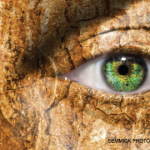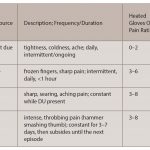The patient expressed difficulty with overhead motions, and she reported a sense of decreased balance and proprioception since being diagnosed with scleroderma. Her physical therapist has incorporated many balance activities on the DynaDisc and AIREX foam balance pad to help improve her proprioception and coordination. Exercises that focus on lower extremity strengthening have also been incorporated into the program, such as lateral band walks and squats.
In Sum
Rehabilitation and therapy can’t heal scleroderma, but therapy can help maintain and improve the range of motion in the hands and improve the patient’s overall function. Exercising and stretching regularly can help delay, and sometimes prevent, the development of contractures, which can have a severe impact on quality of life.
Prescribing a program early in the course of a patient’s illness that focuses on endurance and strength, in addition to stretching, can help patients maintain their functional status.
The clinical presentation and needs of the patient with scleroderma can vary, which is why every patient should be given an individualized program to help improve their specific symptoms, address limitations and maximize outcomes.
 Lauren Tarsi is in her last year of graduate school at Northeastern University and will graduate with a clinical doctorate in physical therapy in May 2015. Lauren has a strong interest in orthopedic physical therapy and looks forward to starting her career as a physical therapist soon.
Lauren Tarsi is in her last year of graduate school at Northeastern University and will graduate with a clinical doctorate in physical therapy in May 2015. Lauren has a strong interest in orthopedic physical therapy and looks forward to starting her career as a physical therapist soon.
 Marie B. Corkery, PT, DPT, MHS, FAAOMPT, is an associate clinical professor in the Department of Physical Therapy, Movement and Rehabilitation Sciences, Northeastern University, Boston.
Marie B. Corkery, PT, DPT, MHS, FAAOMPT, is an associate clinical professor in the Department of Physical Therapy, Movement and Rehabilitation Sciences, Northeastern University, Boston.
References
- Gabrielli A, Avvedimento E, Krieg T. Scleroderma. N Engl J Med. 2009 May 7:1989–2003.
- Johnstone EM, Hutchinson CE, Vail A, et al. Acro-osteolysis in systemic sclerosis is associated with digital ischaemia and severe calcinosis. Rheumatology (Oxford). 2012 Dec;51(12):1–5.
- Merkel P. Scleroderma (also known as systemic sclerosis). The American College of Rheumatology. Updated February 2013.
- Chung L, Utz PJ. Antibodies in scleroderma: Direct pathogenicity and phenotypic association. Curr Rheumatol Rep. 2004 Apr;6(2):156–163.
- Nitsche A. Raynaud, digital ulcers and calcinosis in scleroderma. Reumatol Clin. 2012 Sep–Oct;8(5):270–277.
- Scleroderma and your healthcare profession. Scleroderma Society. 2013. Accessed on March 29, 2015.
- Kucan J, Robson M, Heggers J, Ko F. Comparison of silver sulfadiazine, povidone-iodine and physiologic saline in the treatment of chronic pressure ulcers. J Am Geriatr Soc. 1981 May;29(5):232–235.
- Scleroderma. National Institute of Arthritis and Musculoskeletal and Skin Diseases. 2012. Accessed on Dec. 17, 2014.
- Casale R, Buonocore M, Matucci-Cerinic M. Systemic sclerosis (scleroderma): An integrated challenge in rehabilitation. Arch Phys Med Rehabil. 1997 Jul;78(7):767–773.
- Bongi SM, Del Rosso A, Galluccio F, et al. Efficacy of connective tissue massage and McMennell joint manipulation in the rehabilitative treatment of the hands in systemic sclerosis. Clin Rheumatol. 2009;28(10):1167–1173.
- Baker NA, Aufman EL, Poole JL. Computer use problems and accommodation strategies at work and home for people with systemic sclerosis: A needs assessment. Am J Occup Ther. 2012 May–Jun;66(3):368–375.
- Mayes MD, Ho KT. Understanding and managing scleroderma. Scleroderma Foundation. Accessed on Dec. 31, 2014.



